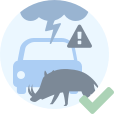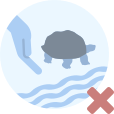
Go to our visitor centres, information points and ecomuseums to get the most out of your visit.
Together with the Río Viejo trail, this route offers the visitor an easy, entertaining and pleasant tour of the Guadalhorce Desembocadura Natural Park , with the particularity that in a very small physical space it will be possible to observe several closely related habitats (fluvial, lagoon, coastline and marine environment). The fact of being a practically flat path with a sandy or compacted earth surface and with an appropriate width to comfortably carry out group activities, especially educational visits, makes this path a site of great potential for public use, environmental education and also for ornithological research, since without a doubt it will be the birds that are most likely to attract us, whether to identify them, photograph them, film them, listen to them or simply study their biology. However, this place also hides other valuable resources related to the environment, history and traditional uses that should also be taken into consideration.
The name of this trail is due to the fact that it borders the popularly known as "Laguna Grande", the largest flooded area within the natural area. It is part of a set of flooded areas, the result in many cases of human activity and therefore having an artificial origin. In fact, although the Guadalhorce delta was originally an excellent cultivation area during the 1960s, with the exception of the marshes closest to the beach that were flooded by storms, the open-air extraction of sand and gravel from the late 1960s. the 70s and early 80s favoured the creation of more or less depressed excavations of the land. Once abandoned, these depressions were filled with water by infiltration as well as by storm flooding. The result that we see today from the path is the result of the restoration programmes carried out on the old lagoons, some of them brackish or salty and others with sweeter waters, and which have been carried out to favour the settlement, reproduction and the feeding of numerous species of birds that visit this humid zone that is transformed every year.
The tour begins at the same point as the "Río Viejo" path, on the butte on the right bank of the Guadalhorce river and in front of the very important Phoenician site of Cerro del Villar, a bygone city of bourgeois merchants founded between the end of the 9th century and beginning of the 8th century BC. Initially we will cross over the current bed of the mentioned river, at a point where it is worth stopping to contemplate the views and try to discover some of the birds that pass through or are related to the river habitat. There will also appear those that benefit from the numerous possibilities of refuge and even nesting provided by the artificial infrastructures existing in the vicinity, including the same bridge on which we are. Common and Red-rumped swallows, common planes, marsh harriers, ospreys and booted eagles, various water birds, gulls of various species, cormorants and many other species make this place a valuable observation post.
Accompanied on both sides of the first section of the road by reed beds and some arboreal feet that are the fruit of recent plantations such as stone pines, wild olive trees, pomegranates, holm oaks and even quinces, we gradually approach another landmark that must be visited and stopped at. 980 metres from the beginning of the trail is the Laguna Escondida observatory, from which we will have the opportunity to view numerous birds very close to our position. The binoculars and telescopes are very valuable tools here in order to be able to identify them correctly, this being practically the only place where certain species can be observed because the Laguna Escondida is one of the few that contains almost fresh waters and not brackish or salty, as happens in other flooded areas of the natural setting. Hence the absence on its shores of the salicornia cover that is typical of other more saline areas. white-headed duck, bittern or kingfisher are, perhaps, some of the most unique birds that can be viewed from this observatory, and compete in rarity and relevance with other animals that are also seen on extraordinary occasions, such as otters.
A little further on, the path leads us to the second wildlife sighting point, the Laguna Grande observatory. Given its somewhat elevated position, this facility provides us with a wide viewshed over the lagoon of the same name, a place worthy of our attention, respect and silence so as not to disturb the many birds that swarm almost at our feet over the waters and banks. Stilts, coots, avocets, egrets, pile drivers, snipe, shoveler ducks, blueberries, white jars, white-headed ducks, cormorants, beaked gulls, flamingos, grebes, turnstones, grey and imperial herons and a long list of birds take advantage of these highly saline waters to look for food, shelter and a place to nest, the leprous tortoises also being present and easily visible in the sun. With a bit of luck we could also locate some birds of prey that use these lands as hunting grounds, although they do not nest in them, not being difficult to discover booted eagles, marsh harriers, common kestrels and even, in winter, ospreys.
Along our walk, it is certain that we will be struck by the presence, next to the path, of a series of remains of linear constructions almost at ground level and U-shaped, today half-buried and partially covered with natural vegetation. They insistently remind us of the agricultural past of the "La Isla" farm, so well-known because of its isolated position between the two arms of the Guadalhorce and the sea. These constructions were nothing other than the old canalisations (culverts) for the irrigation of sugar cane and the crops in general that occupied the area, including the areas that today are under water, being popularly called "atajeas". Originally, these pipelines were interconnected in a perfectly controllable network by means of distribution boxes, which ensured a magnificent and continuous production of sugar cane.
Once we have reached a more open area and populated with tamarisks, reeds, glassworts and even with some date palm, we will end our journey reaching the sands of the beach, at the height of a fenced and signposted area in which we have under no circumstances to penetrate (and neither do our dogs) as it is an extremely vulnerable habitat. Here the natural regeneration of the camomile vegetation typical of the coastline ecosystem is taking place little by little, and that due to trampling can disappear, already seeing numerous specimens of maritime thistle. This is also a habitat in which the plover spontaneously nests and therefore extreme precautions must be taken in order to guarantee the necessary tranquility that this species needs in order to carry out its reproductive tasks. Accessing the beach thus ends our journey but not the enjoyment of the natural setting, because the landscape that surrounds us, the presence of the sea and the numerous sea or coastal birds that meet here will surely continue to give us pleasant moments of joy.






The observatory is accessed on foot via the Río Viejo path, along which we will travel for 1564 metres from the beginning. To get to the point where this path begins from Malaga city, heading west along Avenida de Andalucía, we take the MA-20 Algeciras-Cádiz motorway. If, on the other hand, we leave the city on Avenida de Velázquez, we will initially continue along the MA-21 road towards Torremolinos, turn right at exit 4A, then take the MA-22 motorway to the port of Malaga, as signposted. We leave this road at a roundabout taking the second exit to the left towards "La Azucarera", and immediately afterwards we will return to the MA-21 but this time heading towards Malaga, although we will leave this road almost immediately, turning off to the right on the exit towards the MA-20 Algeciras-Cádiz motorway.
In both cases, either coming from Avenida de Andalucía or Avenida de Velázquez, we will continue along the MA-20 motorway until Km 4, where we turn right at exit 3 (San Julián and Guadalmar). Continuing towards Guadalmar we find a roundabout at the entrance of the urbanisation where we will take the exit to the left, along the Street Guadalhorce. When we see a church we should park the vehicle (GPS coordinates: longitude 4 ° 27 '52.5 "West and latitude 36 ° 40' 10.1" North). We continue, on foot, along the aforementioned Guadalhorce street for about 300 metres until we come across a dirt track that ascends to the left next to a stone portico with a chain. Once at the top of the river berm, we will walk northwest for another 260 metres, until we reach the starting point of the trail.

Go to our visitor centres, information points and ecomuseums to get the most out of your visit.

Do not disturb or feed the animals. You would negatively alter their behavior.

Check the weather forecast before starting your activity.

Bring water, sun protection, suitable clothing and footwear.

Bring a mobile phone with enough battery in case of emergency (112), but remember that there is not always coverage.

For your safety and that of the environment, do not go off the signposted trail or take shortcuts.

Extreme caution in adverse conditions and in the occasional presence of animals or motor vehicles.

Follow the recommendations and comply with the regulations at all times

Respect the facilities put at your disposal. We all pay for its maintenance.

Help prevent fires. Do not throw cigarettes or any other object that produces combustion.

Trash doesn't come back alone. Take it with you to the nearest container. Reduce, reuse, recycle.

Avoid going out alone. If you do, communicate the route and time of return to other people.

Noise is another form of pollution. In silence you will enjoy your experience more.

Live respectfully with the locals and other users. Respect private property.

Facilitate use for people with special needs.

By consuming local products and counting on local companies, you will contribute to rural development.

Practice responsible tourism and committed to the environment. Be a true ecotourist!

Never leave your pet in the wild. It would endanger the flora and fauna of the place.

Get around in a sustainable way: public transport, bicycle, on foot, electric or shared vehicle ... Park in the designated places

Do not leave a trace of your passage through nature. The best memory you can take with you is your own photograph.

Your safety is our concern, but it is your responsibility.

The conservation of natural spaces is also in your hands. Thank you for your collaboration!

Find out in advance about the possible existence of hunting activity and remember that all public use facilities are declared safety zones.



